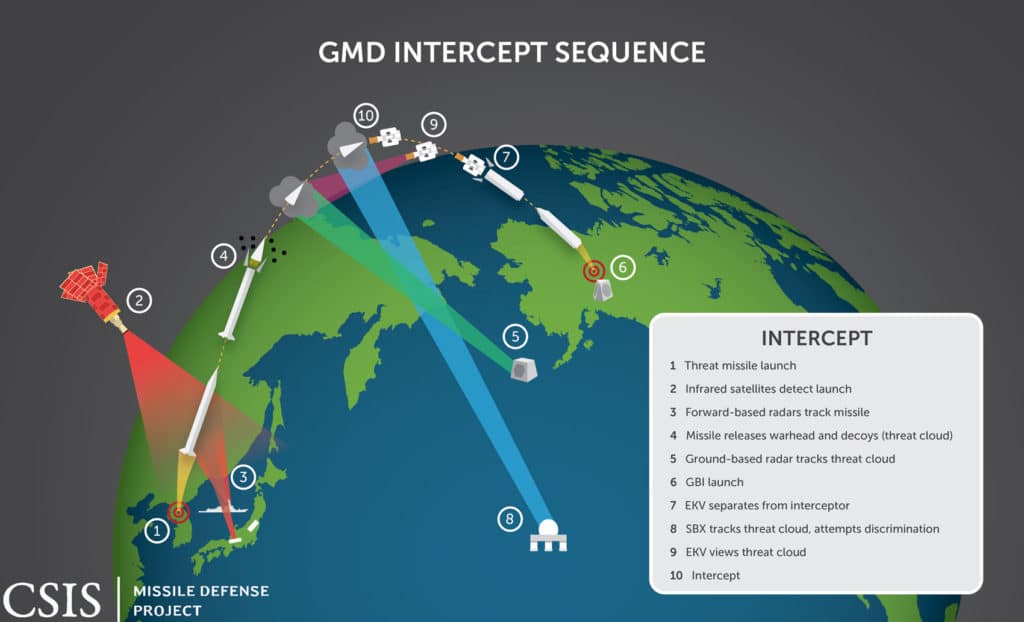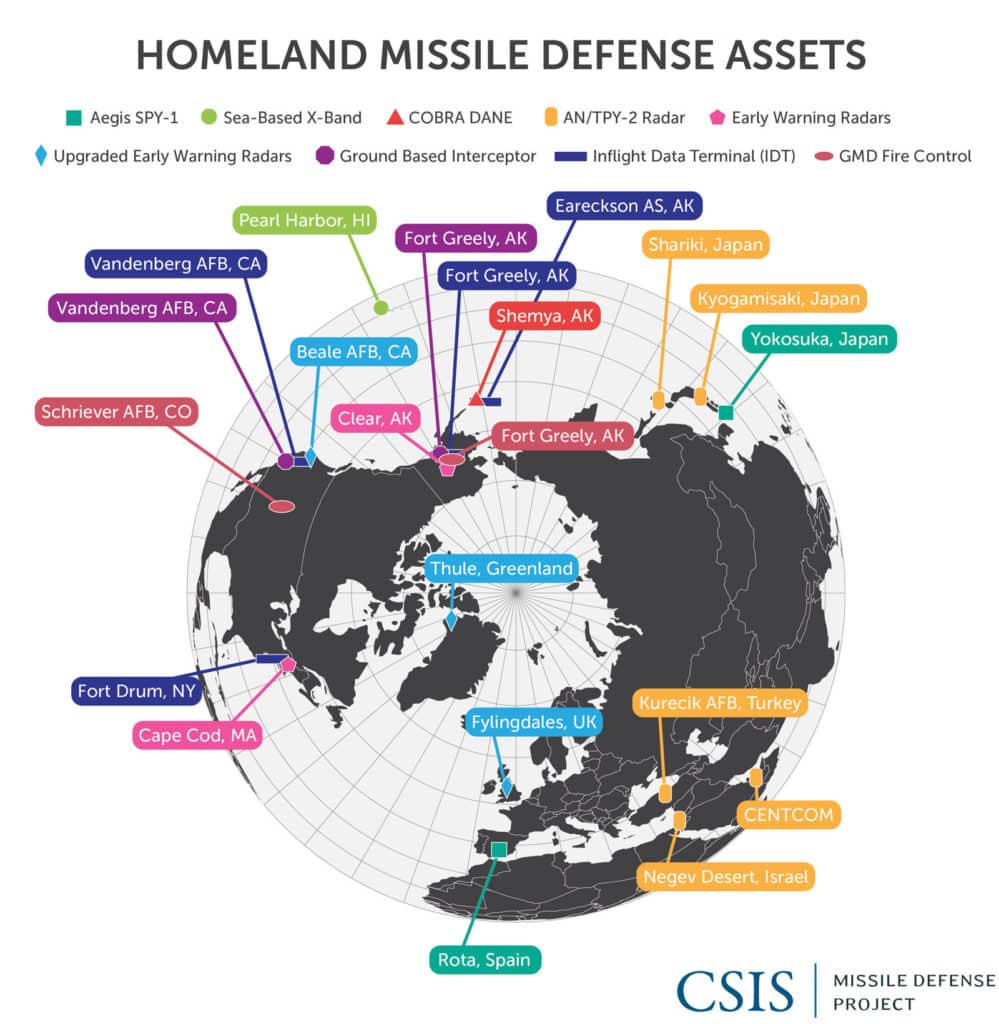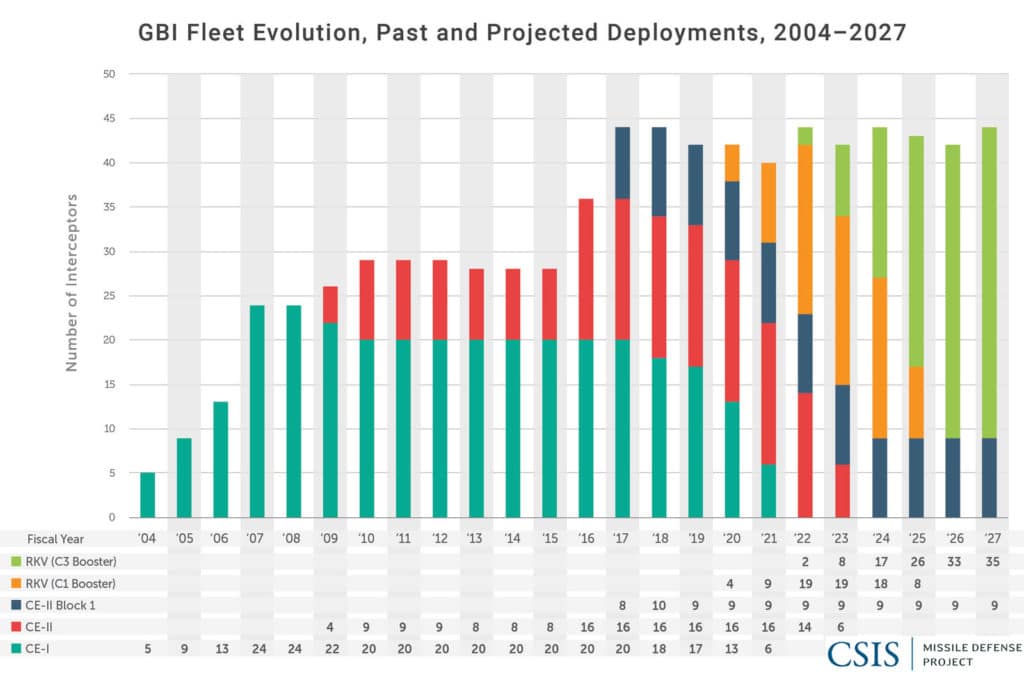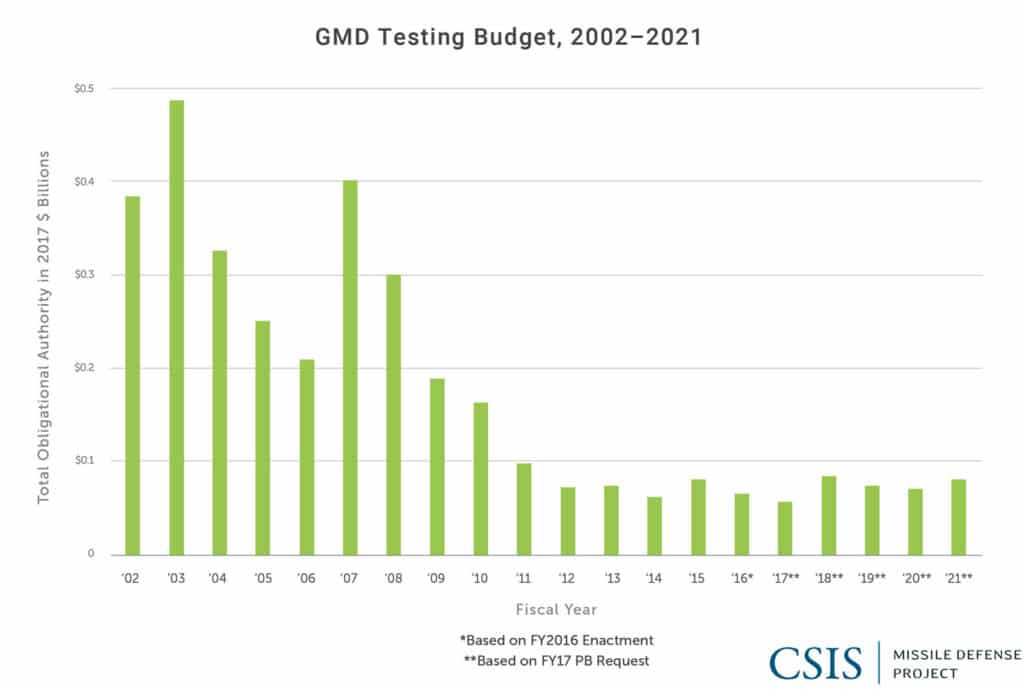Ground-based Midcourse Defense FAQs
What is the Ground-based Midcourse Defense system?
The Ground-based Midcourse Defense (GMD) system is currently the only U.S. missile defense system devoted to defending the U.S. homeland from long-range ballistic missile attacks. GMD and its associated elements span 15 time zones, including Ground-based Interceptors (GBIs) at two locations (Ft. Greely, Alaska and Vandenberg AFB, CA), seven types of sensors on land, sea, and space, and multiple and distributed fire control systems. By the end of 2017, there will be 44 deployed GBIs, 40 based at Ft. Greely, and four at Vandenberg AFB.
When ballistic missile defense sensors detect a missile launch, these data are fused and fed into the GMD fire control system, which is used to launch one or more GBIs. The GBI will fly into the path of an incoming missile before releasing an Exoatmospheric Kill Vehicle (EKV), which uses onboard sensors to hunt down and physically collide with the warhead, destroying it on impact.
What makes GMD different from other missile defense systems?
GMD is designed expressly to counter long-range, intercontinental class ballistic missiles which threaten the U.S. homeland. It uses a three-stage booster, giving the necessary “legs” to perform intercepts over great distances. This range gives GMD by far the greatest coverage area of any U.S. missile defense system, defending (to a varying degree) all fifty states and Canada. Other missile defense systems, including Aegis, THAAD, and Patriot, are generally classified as “regional” systems, and are geared toward short to intermediate range ballistic missile threats. While some may have homeland defense applications in some circumstances, they have much smaller coverage areas than GMD, and generally much less capability, if any, against ICBMs.
Conversely, GMD is not capable of shorter range, regional defense missions. North Korea’s short and medium range missiles threatening South Korea and Japan, for example, fall outside of GMD’s engagement envelope. These threats require other solutions, such as Aegis, THAAD, or Patriot.
What is the purpose of this test? Why is it important?
In general, GMD flight tests are a means of confirm the overall functionality of the system. In addition to testing the interceptor, flight tests also exercise many of GMD’s associated sensor and command and control elements. They are also used to identify any potential flaws in the system not detected in ground tests, which in turn informs any corrective action required. This is the first intercept test of the GMD system since its successful intercept in June 2014 (FTG-06b).
This test will also be the first intercept test of a newer EKV design, the Capability Enhancement-2 Block I (CE-2 Blk I). Among other improvements, this kill vehicle features an upgraded Divert Attitude Control System (DACS), which allows the kill vehicle to maneuver in space. Eight CE-2 Blk I EKVs are slated for deployment to Ft. Greely by the end of 2017. A failure in this intercept tests could, however, delay this deployment.
This test will furthermore be the first GMD intercept test against an ICBM-class target. Prior intercept tests have, however, used intermediate-range ballistic missile targets approaching ICBM speeds.
How has GMD performed in past intercept tests?
Prior to this test, there have been 30 GBI flight tests since 1999, not including one “no-test” due to target failure. Seventeen of these 30 have been intercept tests involving a target ballistic missile. Of these seventeen, there have been nine successful intercepts for a success rate of 53%. Numerous factors have contributed to this record, including inconsistencies in kill vehicle manufacturing, and anomalies in test-only equipment. For full testing history of GMD, see Missile Defense 2020: Next Steps in Defending the Homeland, pages 73-75.
GMD Multimedia Resources
All multimedia is free-use with attribution to the CSIS Missile Defense Project. For questions or assistance, please contact Ian Williams, iwilliams@csis.org.
VIDEOS
How the GMD system works
Hit-to-kill ballistic missile defense is the ultimate precision guidance challenge. Many elements must come together to achieve a successful intercept.
What is needed to improve GMD
Protecting the homeland is regularly identified as the top priority of U.S. missile defense efforts. As missile threats grow, however, today’s defenses could be outmatched, unless steps are taken to improve reliability and capacity.
INFOGRAPHICS
(click for high resolution)
GMD Intercept Sequence
Upon the launch of a hostile long-range ballistic missile, a network of infrared satellites alerts the system, which cues a network of ground- and sea-based radars. These classify the threat, determine its trajectory, and compute a firing solution.
Homeland Missile Defense Assets
GMD and its associated systems span 15 time zones, including interceptors at two locations, seven types of sensors on land, sea, and space, and multiple and distributed fire control systems.
GMD Intercept
Once released from the GBI booster, the kill vehicle uses an onboard suite of electro-optical and infrared sensors to identify and collide with the warhead.
Exoatmospheric Kill Vehicle (EKV)
There are four variants of the EKV deployed or in development. The oldest is the Capability Enhancement-1 (CE-1), first deployed in 2004. This was followed by the CE-2, first deployed in 2009, which featured seeker enhancements and other upgrades to address obsolescence issues. The CE-2 Block 1 is equipped with an improved system of divert thrusters, along with other enhancements. The Redesigned Kill Vehicle (RKV) is the next generation of kill vehicle, which is expected to have a a simplified design with much greater reliability than previous EKV models.
GBI Fleet Evolution
One limitation in MDA’s current plan to improve GMD is the reduction in near-term capacity. The planned production gap will coincide with a 10 percent dip in the number of operationally deployed interceptors, resulting in only 40 GBIs by 2021.
INTERACTIVE MODELS
Ground-based Interceptor
The Ground-based Interceptor (GBI) is a component of the Ground-based Midcourse Defense (GMD) System. GBIs are silo-launched and intercept ballistic missiles in their midcourse, while they are outside of the atmosphere and at their highest trajectory.
BUDGET GRAPHS
Homeland Actual Spending and Future Year Defense Plans, 2000-2021
From a budgetary standpoint, homeland missile defense has been subject to decline relative to regional defenses as well as to the downward budgetary pressures that exist throughout MDA and DoD more broadly. At its height in 2002, homeland-related spending approached $4.5 billion, but
was $2 billion by 2016 (all figures in adjusted 2017 dollars).
GMD Testing Budget, 2001-2021
RELATED LINKS
CSIS Report: Missile Defense 2020: Next Steps for Defending the Homeland (April 2017)
Missile Defense 2020: All Illustrations
Ground-based Midcourse Defense
Ground-based Interceptors
North Korean Missile Database
North Korea Missile Launches: 1984-Present
Full Database: Defense Systems
Full Database: Missiles of the World






